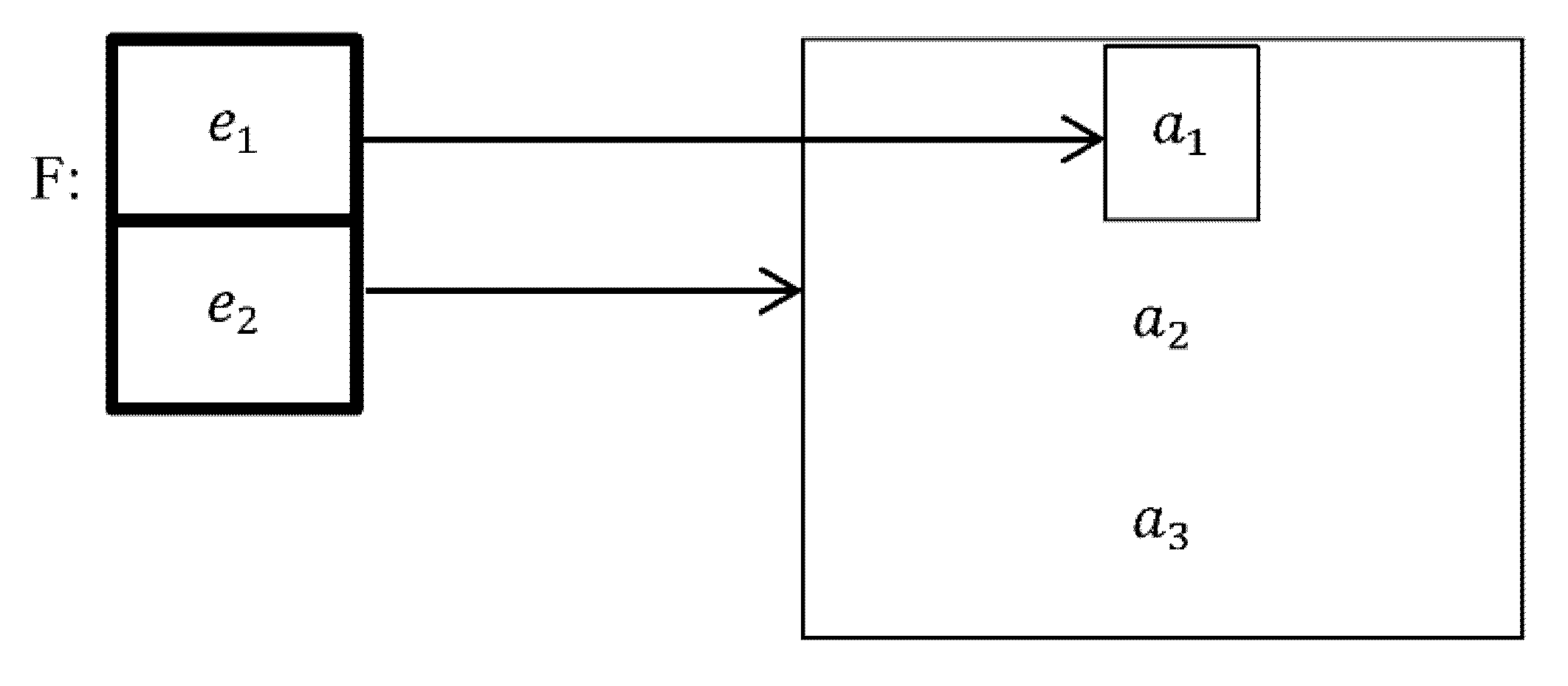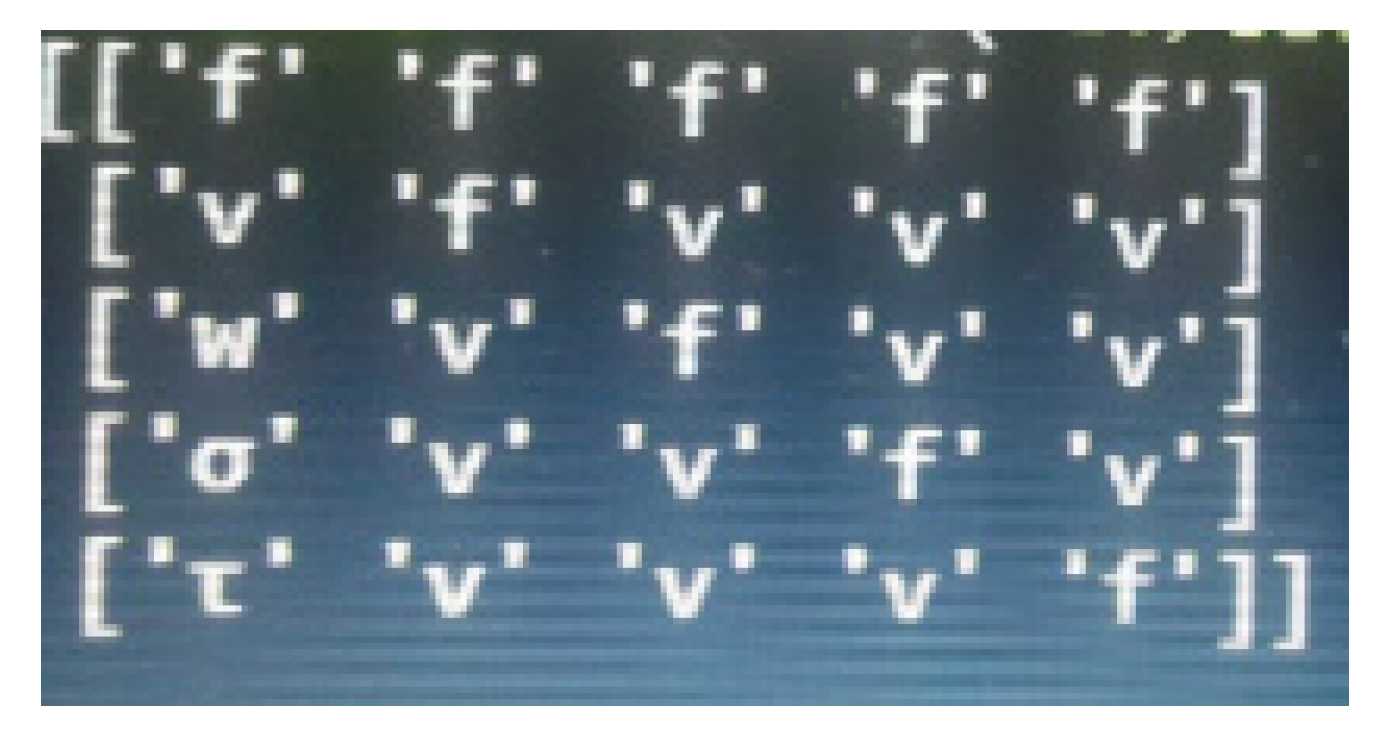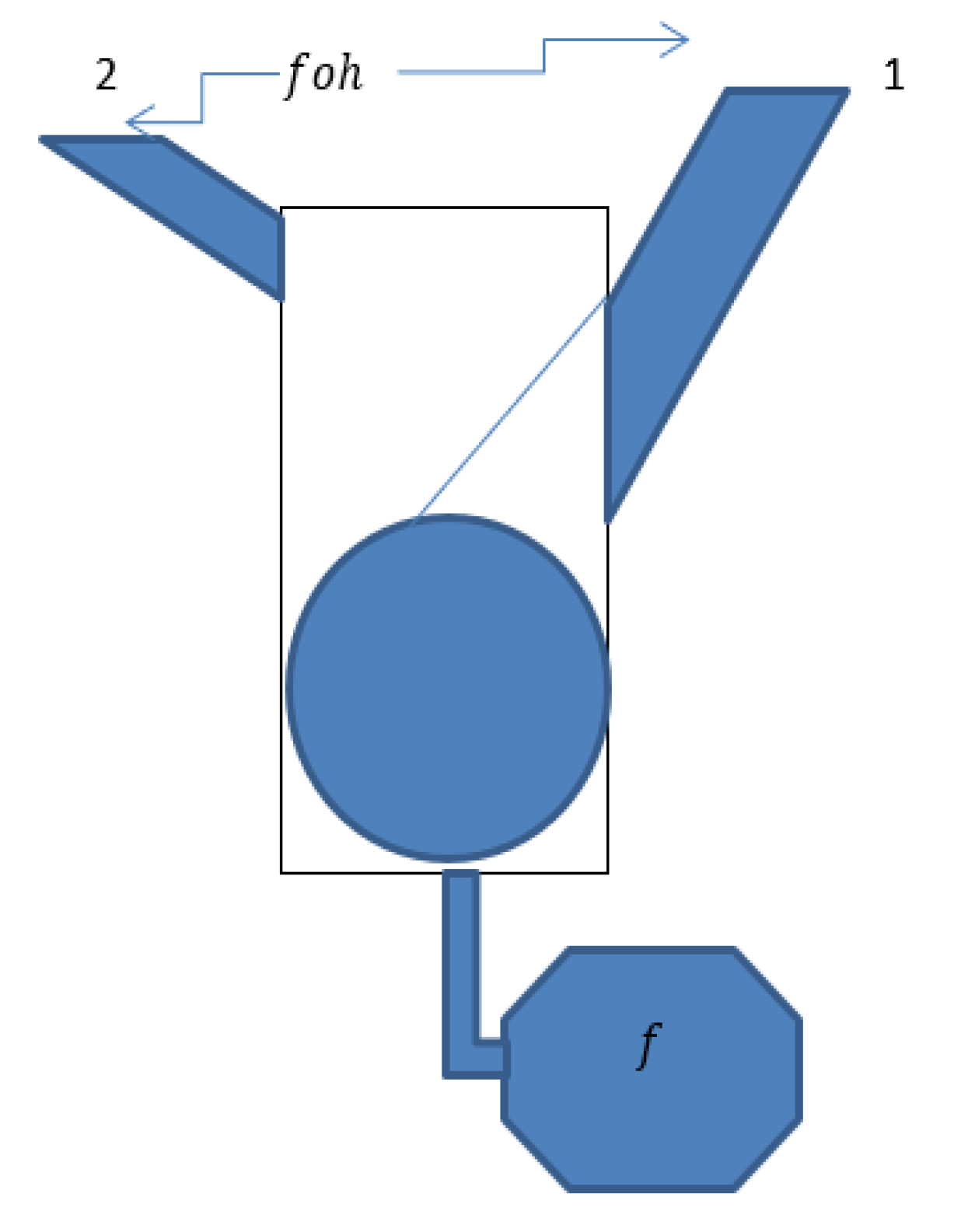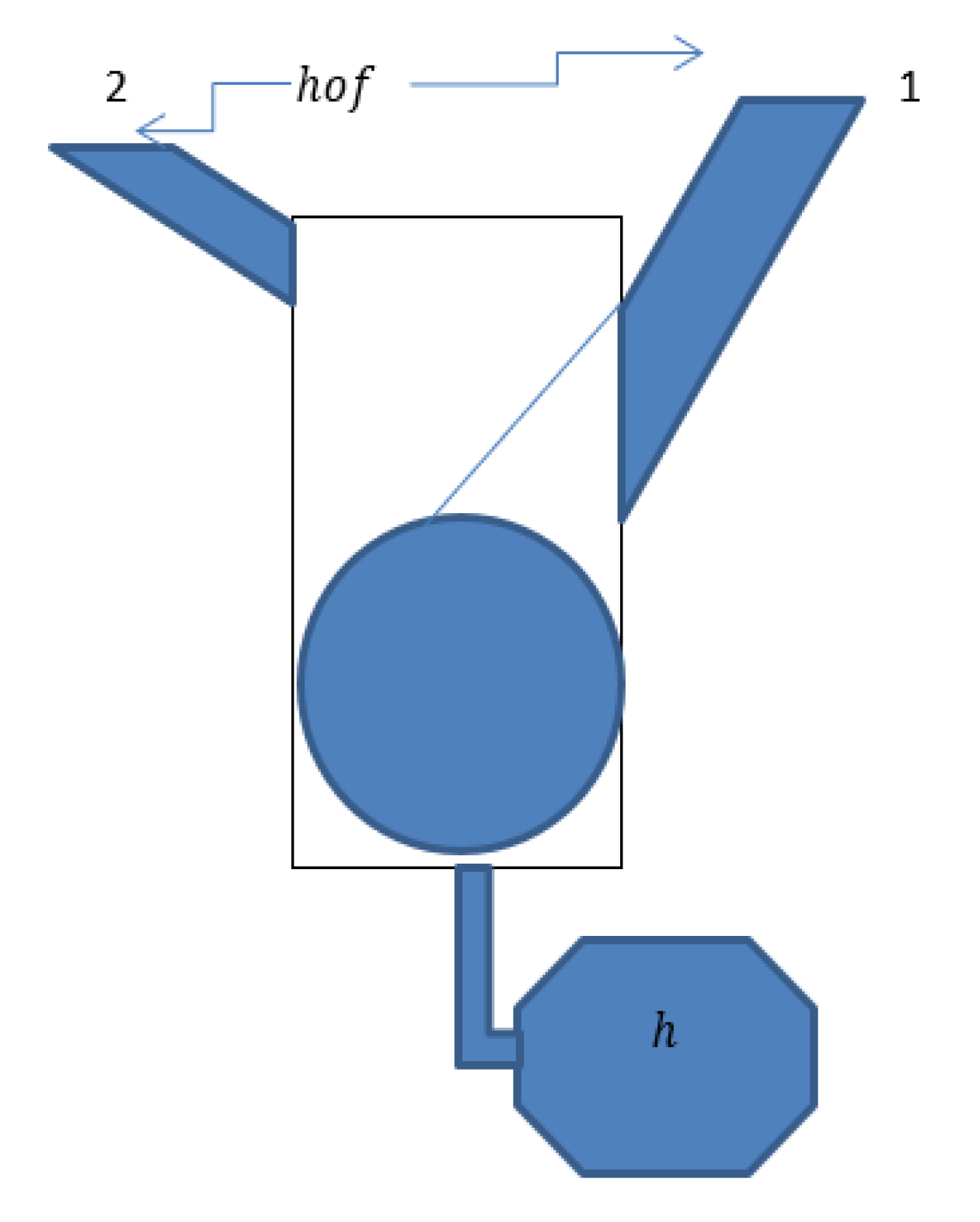Fuzzy Logical Algebra and Study of the Effectiveness of Medications for COVID-19
Abstract
:1. Introduction
2. Preliminary
- (i)
- (ii)
- (iii)
- and → , for all .
- (iv)
- For all → .
- (v)
- For all → .
- (i)
- (P-order) and .
- (ii)
- (R-order) and .
- (iii)
- (Equality) and .
- (1)
- ,
- (2)
- ,
- (3)
- ,
- (4)
- ,
3. Cubic Soft -Subalgebras in -Algebras and Its Application for COVID-19
| from numpy import array |
| X = ['f','v','w','σ','τ'] |
| i = 0 |
| lst = array (range (25), dtype = str). reshape (5,5) |
| for a in X: |
| j = 0 |
| for b in X: |
| # print (a, ' ', b) |
| if ((a == 'f') or (a == b) : |
| m = 'f' |
| elif ((b = 'f')): |
| m = a |
| elif ((a! = 'f') and (b! = 'f') ): |
| m = 'v' |
| lst [i,j] = m |
| j = j + 1 |
| I = I + 1 |
| print(lst) |
- (1)
- For any R-cubic soft subset of (CSδ-SA), it is not necessary that each one is (CSδ-SA).
- (2)
- For any P-cubic soft subset of (CSδ-SA), it is not necessary that each one is (CSδ-SA) too.
4. Comparative Study
5. Conclusions
Author Contributions
Funding
Institutional Review Board Statement
Informed Consent Statement
Data Availability Statement
Acknowledgments
Conflicts of Interest
References
- Maji, P.; Roy, A.; Biswas, R. An application of soft sets in a decision making problem. Comput. Math. Appl. 2002, 44, 1077–1083. [Google Scholar] [CrossRef] [Green Version]
- Biswas, R. Rosenfeld’s fuzzy subgroups with interval-valued membership functions. Fuzzy Sets Syst. 1994, 63, 87–90. [Google Scholar] [CrossRef]
- Khalil, S.M.; Abbas, N.M.A. New Technical Using Nano in Medical Field to Determine Medications that are Suitable Activities for COVID-19. In Data Intelligence and Cognitive Informatics. Algorithms for Intelligent Systems; Springer: Singapore, 2021; pp. 917–921. [Google Scholar] [CrossRef]
- Arfan, M.; Alrabaiah, H.; Rahman, M.U.; Sun, Y.-L.; Hashim, A.S.; Pansera, B.A.; Ahmadian, A.; Salahshour, S. Investigation of fractal-fractional order model of COVID-19 in Pakistan under Atangana-Baleanu Caputo (ABC) derivative. Results Phys. 2021, 24, 104046. [Google Scholar] [CrossRef]
- Zhong, B.; Luo, W.; Li, H.; Zhang, Q.; Liu, X.; Li, W.; Li, Y. Knowledge, attitudes, and practices towards COVID-19 among chinese residents during the rapid rise period of the COVID-19 Outbreak: A quick online cross-sectional survey. Int. J. Biol. Sci. 2020, 16, 1745–1752. [Google Scholar] [CrossRef]
- Khalil, S.M. Decision making using algebraic operations on soft effect matrix as new category of similarity measures and study their application in medical diagnosis problems. J. Intell. Fuzzy Syst. 2019, 37, 1865–1877. [Google Scholar] [CrossRef]
- Khalil, S.M. Decision making using new category of similarity measures and study their applications in medical diagnosis problems. Afr. Mat. 2021, 32, 865–878. [Google Scholar] [CrossRef]
- Zadeh, A.L. Fuzzy sets. Inf. Control 1965, 8, 338–353. [Google Scholar] [CrossRef] [Green Version]
- Xi, O.G. Fuzzy algebras. Math. Jpn. 1991, 36, 935–942. [Google Scholar]
- Muhiuddin, G.; Song, S.Z.; Kim, H.S.; Jun, Y.B. Characterizations of fuzzy subalgebras in BCK/BCI-algebras. Appl. Math. Sci. 2015, 9, 7187–7196. [Google Scholar] [CrossRef]
- Khalil, S.M.; Hameed, F. Applications of fuzzy ρ-ideals in ρ-algebras. Soft Comput. 2020, 24, 13997–14004. [Google Scholar] [CrossRef]
- Molodtsov, D. Soft set theory—First results. Comput. Math. Appl. 1999, 37, 19–31. [Google Scholar] [CrossRef] [Green Version]
- Khalil, S.M.; Hameed, F. An algorithm for generating permutation algebras using soft spaces. J. Taibah Univ. Sci. 2018, 12, 299–308. [Google Scholar] [CrossRef] [Green Version]
- Jun, Y.B.; Lee, K.J.; Park, C.H. Fuzzy soft set theory applied to BCK/BCI-algebras. Comput. Math. Appl. 2010, 59, 3180–3192. [Google Scholar] [CrossRef] [Green Version]
- Zadeh, L.A. The concept of a linguistic variable and its application to approximate reasoning—I. Inf. Sci. 1975, 8, 199–249. [Google Scholar] [CrossRef]
- Jun, Y.B.; Kim, C.S.; Yang, K.O. Cubic sets. Ann. Fuzzy Math. Inf. 2012, 4, 83–98. [Google Scholar]
- Khalil, S.M.; Hassan, A.N. The Characterizations of δ-Algebras with Their Ideals. J. Physics: Conf. Ser. 2021, 1999, 012108. [Google Scholar] [CrossRef]
- Gorzalczany, M.B. A method of inference in approximate reasoning based on interval-valued fuzzy sets. Fuzzy Sets Syst. 1987, 21, 1–17. [Google Scholar] [CrossRef]
- Muhiuddin, G.; Al-roqi, A.M. Cubic soft sets with applications in BCK/BCI-algebras. Ann. Fuzzy Math. Inf. 2014, 8, 291–304. [Google Scholar]
- Saghir, S.A.; AlGabri, A.N.; Alagawany, M.M.; Attia, A.Y.; Alyileili, S.R.; Elnesr, S.S.; Shafi, E.M.; Al-Shargi, O.Y.; Al-Balagi, N.; Alwajeeh, A.S.; et al. Chloroquine and Hydroxychloroquine for the Prevention and Treatment of COVID-19: A Fiction, Hope or Hype? An Updated Review. Ther. Clin. Risk Manag. 2021, 17, 371–387. [Google Scholar] [CrossRef]
- Nojomi, M.; Yassin, Z.; Keyvani, H.; Makiani, M.J.; Roham, M.; Laali, A.; Dehghan, N.; Navaei, M.; Ranjbar, M. Effect of Arbidol (Umifenovir) on COVID-19: A randomized controlled trial. BMC Infect. Dis. 2020, 20, 954. [Google Scholar] [CrossRef]
- Godlee, F. Covid-19: The lost lessons of Tamiflu. BMJ 2020, 371, m4701. [Google Scholar] [CrossRef]
- Kalantari, S.; Fard, S.R.; Maleki, D.; Taher, M.T.; Yassin, Z.; Alimohamadi, Y.; Minaeian, S. Comparing the effectiveness of Atazanavir/Ritonavir/Dolutegravir/Hydroxychloroquine and Lopinavir/Ritonavir/Hydroxychloroquine treatment regimens in COVID-19 patients. J. Med. Virol. 2021, 93, 6557–6565. [Google Scholar] [CrossRef]
- Beigel, J.H.; Tomashek, K.M.; Dodd, L.E.; Mehta, A.K.; Zingman, B.S.; Kalil, A.C.; Hohmann, E.; Chu, H.Y.; Luetkemeyer, A.; Kline, S.; et al. Remdesivir for the Treatment of Covid-19—Final Report. N. Engl. J. Med. 2020, 383, 1813–1826. [Google Scholar] [CrossRef]
- Mahmood, T. A Novel Approach towards Bipolar Soft Sets and Their Applications. J. Math. 2020, 2020, 1–11. [Google Scholar] [CrossRef]




| 〈[0.6, 0.8], 0.2〉 | 〈[0.5, 0.6], 0.1〉 | 〈[0.5, 0.8], 0.5〉 | |
| 〈[0.6, 0.7], 0.5〉 | 〈[0.4, 0.6], 0.4〉 | 〈[0.5, 0.8], 0.7〉 | |
| 〈[0.5, 0.7], 0.8〉 | 〈[0.4, 0.5], 0.8〉 | 〈[0.5, 0.7], 0.9〉 | |
| 〈[0.4, 0.6], 0.7〉 | 〈[0.2, 0.5], 0.6〉 | 〈[0.2, 0.4], 0.6〉 | |
| 〈[0.3, 0.5], 0.3〉 | 〈[0.3, 0.4], 0.8〉 | 〈[0.5, 0.7], 0.5〉 |
| 〈[0.4, 0.7], 0.4〉 | 〈[0.6, 0.9], 0.6〉 | 〈[0.5, 0.6], 0.1〉 | 〈[0.4, 0.5], 0.3〉 | |
| 〈[0.4, 0.6], 0.6〉 | 〈[0.4, 0.8], 0.8〉 | 〈[0.4, 0.5], 0.3〉 | 〈[0.4, 0.5], 0.5〉 | |
| 〈[0.4, 0.6], 0.8〉 | 〈[0.6, 0.8], 0.7〉 | 〈[0.4, 0.5], 0.6〉 | 〈[0.3, 0.4], 0.4〉 | |
| 〈[0.1, 0.3], 0.5〉 | 〈[0.3, 0.5], 0.7〉 | 〈[0.3, 0.5], 0.8〉 | 〈[0.1, 0.4], 0.8〉 | |
| 〈[0.4, 0.7], 0.4〉 | 〈[0.5, 0.8], 0.6〉 | 〈[0.2, 0.3], 0.8〉 | 〈[0.2, 0.3], 0.3〉 |
| 〈[0.6, 0.7], 0.4〉 | 〈[0.6, 0.9], 0.6〉 | 〈[0.5, 0.6], 0.1〉 | 〈[0.4, 0.5], 0.3〉 | 〈[0.5, 0.8], 0.5〉 | |
| 〈[0.6, 0.7], 0.6〉 | 〈[0.4, 0.8], 0.8〉 | 〈[0.4, 0.6], 0.4〉 | 〈[0.1, 0.3], 0.5〉 | 〈[0.3, 0.8], 0.7〉 | |
| 〈[0.5, 0.7], 0.8〉 | 〈[0.6, 0.8], 0.7〉 | 〈[0.4, 0.5], 0.8〉 | 〈[0.3, 0.4], 0.4〉 | 〈[0.5, 0.7], 0.9〉 | |
| 〈[0.4, 0.6], 0.7〉 | 〈[0.3, 0.5], 0.7〉 | 〈[0.3, 0.5], 0.8〉 | 〈[0.1, 0.4], 0.8〉 | 〈[0.2, 0.4], 0.6〉 | |
| 〈[0.4, 0.7], 0.4〉 | 〈[0.5, 0.8], 0.6〉 | 〈[0.3, 0.4], 0.8〉 | 〈[0.2, 0.3], 0.3〉 | 〈[0.5, 0.7], 0.5〉 |
| 〈[0.3, 0.5], 0.8〉 | 〈[0.5, 0.8], 0.5〉 | |
| 〈[0.3, 0.6], 0.6〉 | 〈[0.3, 0.8], 0.7〉 | |
| 〈[0.4, 0.5], 0.8〉 | 〈[0.5, 0.7], 0.9〉 | |
| 〈[0.3, 0.4], 0.8〉 | 〈[0.2, 0.4], 0.6〉 | |
| 〈[0.2, 0.4], 0.5〉 | 〈[0.5, 0.7], 0.5〉 |
| 〈[0.3, 0.5], 0.1〉 | 〈[0.5, 0.8], 0.5〉 | |
| 〈[0.2, 0.3], 0.4〉 | 〈[0.3, 0.8], 0.7〉 | |
| 〈[0.4, 0.5], 0.7〉 | 〈[0.5, 0.7], 0.9〉 | |
| 〈[0.3, 0.4], 0.6〉 | 〈[0.2, 0.4], 0.6〉 | |
| 〈[0.2, 0.4], 0.2〉 | 〈[0.5, 0.7], 0.5〉 |
Publisher’s Note: MDPI stays neutral with regard to jurisdictional claims in published maps and institutional affiliations. |
© 2021 by the authors. Licensee MDPI, Basel, Switzerland. This article is an open access article distributed under the terms and conditions of the Creative Commons Attribution (CC BY) license (https://creativecommons.org/licenses/by/4.0/).
Share and Cite
Khalil, S.; Hassan, A.; Alaskar, H.; Khan, W.; Hussain, A. Fuzzy Logical Algebra and Study of the Effectiveness of Medications for COVID-19. Mathematics 2021, 9, 2838. https://doi.org/10.3390/math9222838
Khalil S, Hassan A, Alaskar H, Khan W, Hussain A. Fuzzy Logical Algebra and Study of the Effectiveness of Medications for COVID-19. Mathematics. 2021; 9(22):2838. https://doi.org/10.3390/math9222838
Chicago/Turabian StyleKhalil, Shuker, Ahmed Hassan, Haya Alaskar, Wasiq Khan, and Abir Hussain. 2021. "Fuzzy Logical Algebra and Study of the Effectiveness of Medications for COVID-19" Mathematics 9, no. 22: 2838. https://doi.org/10.3390/math9222838
APA StyleKhalil, S., Hassan, A., Alaskar, H., Khan, W., & Hussain, A. (2021). Fuzzy Logical Algebra and Study of the Effectiveness of Medications for COVID-19. Mathematics, 9(22), 2838. https://doi.org/10.3390/math9222838







